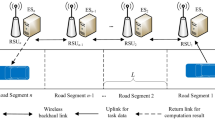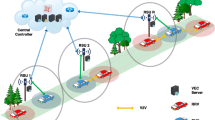Abstract
Vehicles are getting equipped in technology, communication between vehicle and the user is getting better. The vehicular network is an emerging technology to provide mobile users with the flexibility to use various services such as entertainment and navigation on wheels. The users are served with data related to their travel in terms of road map, weather updates, traffic congestions, radio services, social network applications and place of interest. The data communication takes place with the help of Smart On-board Unit (SOBU) present on the vehicle. There is a requirement of compound data computations with firm latency. Vehicle Edge computing (VEC) is the emerging technology that has serves at the edge in the neighbourhood of vehicle that enables data offloading. There will be much of energy consumption and latency resulting from offloading and computations. In this paper smart offloading scheme is proposed that will efficiently harvest the energy and reduce the energy consumption problem. As a performance statistic, the execution cost is used, which accounts for both execution delay and task failure. And also, the offloading scheme is analyzed for single user and multiuser by simulations and the results are compared graphically for battery energy level, average execution cost and channel mode select parameters respectively. The factors affecting both Single-user and multi-user computation are identified from the results. Experimental results show that offloading schemes proposed for single user and multi user work better than the other state-of-the-art algorithms for vehicular networks. This single-user analysis will be a benchmark for developing auto pilot vehicle for people with special needs and multi-user analysis will help in developing to all kinds of Electric Vehicle communication.










Similar content being viewed by others
Data availability
Not Applicable.
Code availability
No.
References
Bayrak AE et al (2020) A system-of-systems approach to the strategic feasibility of modular vehicle fleets. IEEE Trans Syst Man Cybern: Syst 50(7):2716–2728
Cao Y, Li D, Zhang Y, Chen X (2020) Joint optimization of delay-tolerant autonomous electric vehicles charge scheduling and station battery degradation. IEEE Internet Things J 7(9):8590–8599
Chaudhry SA (2021) Designing an efficient and secure message exchange protocol for internet of vehicles. Secur Commun Netw 2021:5554318. 9 pages
Deng S, Huang L, Taheri J, Zomaya AY (2015) Computation offloading for service workflow in mobile cloud computing. IEEE Trans Parallel Distrib Syst 26(12):3317–3329
Ge XH, Tu S, Mao GQ, Wang CX, Han T (2016) 5G ultra-dense celluar networks. IEEE Wirel Commun 23:71–79
Hussain R, Zeadally S (2019) Autonomous cars: research results, issues, and future challenges. IEEE Commun Surv Tutor 21(2):1275–1313. https://doi.org/10.1109/COMST.2018.2869360
Jiang X, Li P, Li B, Zou Y, Wang R (2021) Security-reliability tradeoff for friendly jammer aided multiuser scheduling in energy harvesting communications. Secur Commun Netw 2021:5599334. 16 pages
Lin S-C et al (2018) The architectural implications of autonomous driving: constraints and acceleration. In: Proceedings of the twenty-third international conference on architectural support for programming languages and operating systems, pp 751–766
Liu J, Zhang Q (2018) Offloading schemes in mobile edge computing for ultra-reliable low latency communications. IEEE Access 6:12825–12837
Mao YY, Zhang J, Letaief KB (2016) Dynamic computation offloading for mobile-edge computing with energy harvesting devices. IEEE J Sel Areas Commun 34:3590–3605
Masoudi M, khamidehi B, Cavdar C (2017) Green cloud computing for multi cell networks. In: 2017 IEEE Wireless Communications and Networking Conference (WCNC), San Francisco, USA. IEEE, pp 1–6
Mustafa E, Shuja J, uzZaman SK et al (2021) “Joint wireless power transfer and task offloading in mobile edge computing: a survey. Cluster Computing, pp 1–20
Ning Z, Wang X, Rodrigues JJPC, Xia F (2019) Joint computation offloading, power allocation, and channel assignment for 5G-enabled traffic management systems. IEEE Trans Industr Inf 15(5):3058–3067
Sabitha G, Manimegalai CT, Narayanan K (2017) Reduction of complexity of on-board embedded robotic system processors using code offloading. Wirel Personal Commun 97(4):5089–5098
Shalev-Shwartz S, Shammah S, Shashua A (2016) Safe, multi-agent, reinforcement learning for autonomous driving. [Online]. Available: arxiv.abs/1610.03295.
Sheikh MS, Liang J, Wang W (2020) Security and privacy in vehicular ad hoc network and vehicle cloud computing: a survey. Wirel Commun Mob Comput 2020:5129620. 25 pages
Sheng J, Hu J, Teng X, Wang B, Pan X (2019) Computation offloading strategy in mobile edge computing. Information 10:191
Tassi A, Mavromatis I, Piechocki RJ, Nix A (2019) Secure data offloading strategy for connected and autonomous vehicles. In: 2019 IEEE 89th Vehicular Technology Conference (VTC2019-Spring), pp 1–2
Wu D, Huang X, Xie X, Nie X, Bao L, Qin Z (2021) LEDGE: leveraging edge computing for resilient access management of mobile IoT. IEEE Trans Mob Comput 20(3):1110–1125
Xu X, Fu S, Yuan Y, Luo Y, Qi L, Lin W, Dou W (2018) Multi-objective computation offloading for workflow management in cloudlet-based mobile cloud using NSGA‐II. Comput Intell 35(3):1275–1313
Yao M, Wang X, Gan Q, Lin Y, Huang C (2021) An improved and privacy-preserving mutual authentication scheme with forward secrecy in VANETs. Secur Commun Netw 2021
Zhang J, Zhao X (2020) An overview of user-oriented computation offloading in mobile edge computing. 2020 IEEE World Congress on Services (SERVICES), pp 75–76. https://doi.org/10.1109/SERVICES48979.2020.00029
Author information
Authors and Affiliations
Contributions
The manuscript was written through contributions of all authors. All authors have given approval to the final version of the manuscript.
Corresponding author
Ethics declarations
Ethical approval
Not Applicable.
Informed consent
Not Applicable.
Conflict of interest
The authors have no financial or proprietary interests in any material discussed in this article. The authors declare that they have no conflict of interest.
Additional information
Publisher’s note
Springer Nature remains neutral with regard to jurisdictional claims in published maps and institutional affiliations.
Rights and permissions
Springer Nature or its licensor (e.g. a society or other partner) holds exclusive rights to this article under a publishing agreement with the author(s) or other rightsholder(s); author self-archiving of the accepted manuscript version of this article is solely governed by the terms of such publishing agreement and applicable law.
About this article
Cite this article
Gauni, S., Bhanupriya, P., Kalimuthu, K. et al. Correlation and contrast of multi-user edge computation with single-user edge computation for data offload on terrain electric vehicular applications. Multimed Tools Appl 82, 26563–26575 (2023). https://doi.org/10.1007/s11042-023-14848-6
Received:
Revised:
Accepted:
Published:
Issue Date:
DOI: https://doi.org/10.1007/s11042-023-14848-6




